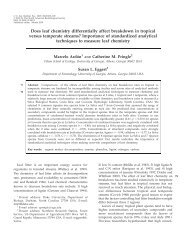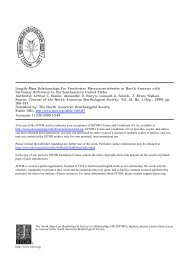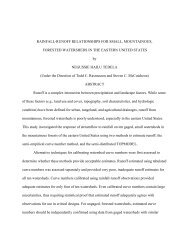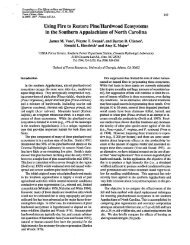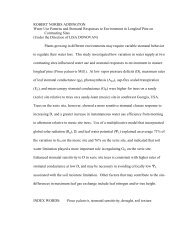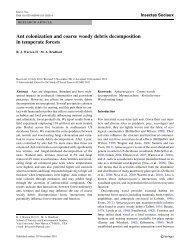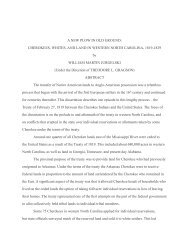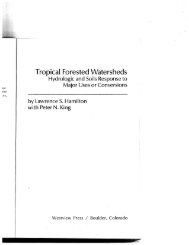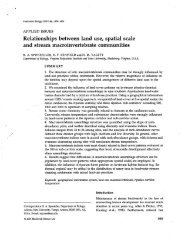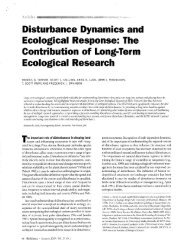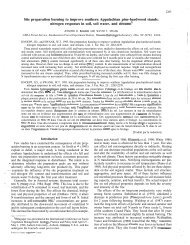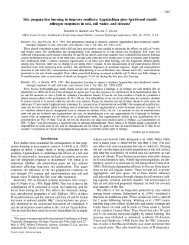biology join - Coweeta LTER - University of Georgia
biology join - Coweeta LTER - University of Georgia
biology join - Coweeta LTER - University of Georgia
You also want an ePaper? Increase the reach of your titles
YUMPU automatically turns print PDFs into web optimized ePapers that Google loves.
Articles<br />
legacies <strong>of</strong> pretreatment conditions. Therefore, it may take<br />
a while before system responses are indicative <strong>of</strong> ecological<br />
processes. For example, patterns <strong>of</strong> nitrate loss from agricultural<br />
systems that vary in management intensity are notably<br />
variable, in part because many studies are initiated before<br />
treatments have fully equilibrated or are conducted over relatively<br />
short periods <strong>of</strong> time. This has led to widely conflicting<br />
reports and little agreement about the best management<br />
practices to decrease nitrate loss. In contrast, the long-term<br />
cropping systems experiment at the KBS site (figure 3) has<br />
enabled comparisons <strong>of</strong> nitrate losses from conventional, notill,<br />
low-input, and organic cropping systems. Each <strong>of</strong> these<br />
treatments had six years to equilibrate before measurement,<br />
and they have been assessed for 11 years, which accounts for<br />
interannual variability (Syswerda et al. 2008). This study has<br />
revealed consistent and marked differences in nitrate losses,<br />
with the low-input and organic systems having about half the<br />
nitrate losses <strong>of</strong> the conventionally managed systems.<br />
Long-term experiments can reveal the importance <strong>of</strong> indirect<br />
effects in ecosystem processes not apparent in the short<br />
term, as well as responses that may change over the long term<br />
(Tilman 1989). At the NTL site, the experimental acidification<br />
<strong>of</strong> a small seepage lake (figure 3) produced numerous<br />
changes driven by indirect interactions related to changes in<br />
the food web rather than by direct consequences <strong>of</strong> lower<br />
pH. For example, the rotifer Keratella taurocephela has displayed<br />
low acid tolerance in laboratory studies but increased<br />
in density throughout the acidification experiment as a result<br />
<strong>of</strong> decreased invertebrate-predator abundance (Gonzalez and<br />
Frost 1994). Keratella taurocephela also underwent morphological<br />
changes in the acidified basin as a result <strong>of</strong> reduced<br />
predation pressure. Responses driven by food-web interactions<br />
were <strong>of</strong>ten the opposite <strong>of</strong> expectations based on laboratory<br />
studies <strong>of</strong> pH tolerance and generally exhibited a time lag;<br />
these unexpected results would not have been observed on time<br />
scales shorter than the response time <strong>of</strong> all trophic levels.<br />
Other opportunities from long-term experiments. Unavoidably,<br />
long-term experiments occur against a backdrop <strong>of</strong> longterm<br />
trends; stochastic ambient conditions, including<br />
climate variability and extremes and infrequent disturbances;<br />
and changes in the abundances <strong>of</strong> predators and<br />
pathogens at scales greater than the experimental units.<br />
Although the inability to control ambient conditions can be<br />
challenging, variability in background conditions can sometimes<br />
also prove fortuitous (Tilman 1989). For example,<br />
long-term experiments can be particularly valuable if they<br />
coincide with climate or weather extremes that provide new<br />
ecological understanding. Of course, the longer an experiment<br />
is conducted, the greater the chances that ambient<br />
conditions will vary in ways that produce insights and even<br />
inspire new experiments. During the Ca-addition studies<br />
at the HBR site (figure 3), an intense ice storm damaged<br />
sugar maple trees, which allowed researchers to document<br />
improved wound repair as one <strong>of</strong> the major responses to<br />
the alleviation <strong>of</strong> Ca deficiency and, presumably, a principal<br />
mechanism underlying increased growth rates (Huggett<br />
et al. 2007). At the CWT site, Yeakley and colleagues<br />
(2003) designed an experiment to investigate the importance<br />
<strong>of</strong> riparian Rhododendron species to nutrient export<br />
to streams. They instrumented treatment and reference<br />
hillslopes, made two years <strong>of</strong> pretreatment measurements,<br />
and then removed all Rhododendron stems from a 10-meter<br />
(m) strip along 30 m <strong>of</strong> stream. Less than two months<br />
later, Hurricane Opal downed most <strong>of</strong> the large trees on<br />
the reference hillslope. Over the course <strong>of</strong> the study, they<br />
found that the hurricane impact on canopy trees had far<br />
greater effects on nutrient export than did the experimental<br />
Rhododendron removal. Finally, a wildfire at the KNZ site<br />
in 1996 reset most <strong>of</strong> the long-term fire treatments in the<br />
60 watersheds at the site (figure 1) by burning them all on<br />
the same date. This afforded the opportunity to sample<br />
a large number <strong>of</strong> sites affected by the same fire but with<br />
a wide array <strong>of</strong> longer-term fire histories. This sampling<br />
revealed the importance <strong>of</strong> the amount <strong>of</strong> time since a prior<br />
fire in determining aboveground net primary productivity<br />
responses to fire (figure 6) and helped researchers interpret<br />
results from other experiments regarding the role <strong>of</strong> soil N<br />
in postfire responses (Blair 1997, Knapp et al. 1998).<br />
Scientists conducting long-term experiments can also<br />
take advantage <strong>of</strong> dramatic changes in community structure,<br />
such as those resulting from extirpation or biological invasion.<br />
For example, at the KBS site, long-term monitoring<br />
<strong>of</strong> predaceous lady beetles (Coccinellidae) in experimental<br />
agricultural treatments has revealed three exotic species<br />
additions since 1988, including the multicolored Asian lady<br />
beetle (Harmonia axyridis). The arrival <strong>of</strong> the soybean aphid<br />
(Aphis glycines) in 2000 reunited these two Asian species in<br />
a new context and resulted in surprising dynamics. Prior to<br />
2000, H. axyridis was a common species; however, after 2000,<br />
it became dominant (figure 7). Moreover, it demonstrated<br />
classic predator–prey cycling with high abundances following<br />
years <strong>of</strong> aphid outbreak (Heimpel et al. 2010); process-level<br />
studies demonstrated strong top-down control <strong>of</strong> A. glycines<br />
by coccinellids (Costamagna and Landis 2006). A further<br />
surprise was that biological control <strong>of</strong> the soybean aphid<br />
was regulated by the structure <strong>of</strong> the surrounding landscape:<br />
Suppression was positively correlated with landscape<br />
diversity at the 1.5-kilometer scale (Gardiner et al. 2009).<br />
Finally, long-term experiments can provide opportunities<br />
to address novel questions that were not part <strong>of</strong><br />
the original motivation for the experiment. Long-term<br />
N-enrichment studies at the ARC site were initially established<br />
as part <strong>of</strong> a broader suite <strong>of</strong> treatments designed<br />
to assess resource limitation and the response <strong>of</strong> tundra<br />
ecosystems to global-change factors (figure 1; Chapin et al.<br />
1995). After 20 years <strong>of</strong> adding N, the researchers shifted<br />
their focus toward asking how much <strong>of</strong> the cumulative N<br />
added still remained in the plots and how this affected C<br />
pools (Mack et al. 2004). Somewhat surprisingly, these plots<br />
had lost significant C, despite greater C inputs (net primary<br />
production) and aboveground C stocks with N addition. Net<br />
384 BioScience • April 2012 / Vol. 62 No. 4 www.biosciencemag.org



